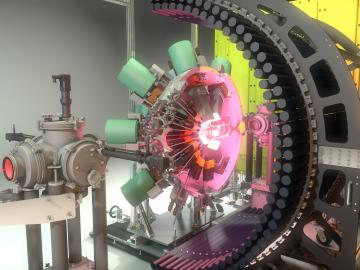
Filter News
Area of Research
- (-) Materials (433)
- (-) National Security (80)
- (-) Supercomputing (319)
- Advanced Manufacturing (34)
- Biological Systems (18)
- Biology and Environment (180)
- Biology and Soft Matter (5)
- Building Technologies (12)
- Chemical and Engineering Materials (4)
- Chemistry and Physics at Interfaces (11)
- Computational Biology (6)
- Computational Chemistry (5)
- Computational Engineering (5)
- Computer Science (19)
- Data (1)
- Electricity and Smart Grid (3)
- Energy Frontier Research Centers (14)
- Energy Science (526)
- Energy Sciences (5)
- Fossil Energy (3)
- Fuel Cycle Science and Technology (3)
- Functional Materials for Energy (16)
- Fusion and Fission (55)
- Fusion Energy (19)
- Geographic Information Science and Technology (3)
- Isotope Development and Production (3)
- Isotopes (36)
- Materials Characterization (2)
- Materials for Computing (36)
- Materials Synthesis from Atoms to Systems (13)
- Materials Under Extremes (12)
- Mathematics (1)
- Neutron Data Analysis and Visualization (4)
- Neutron Science (212)
- Nuclear Science and Technology (75)
- Nuclear Systems Modeling, Simulation and Validation (3)
- Nuclear Systems Technology (1)
- Quantum Condensed Matter (4)
- Quantum information Science (9)
- Reactor Technology (1)
- Sensors and Controls (5)
- Transportation Systems (11)
News Type
News Topics
- 3-D Printing/Advanced Manufacturing (28)
- Advanced Reactors (6)
- Artificial Intelligence (48)
- Big Data (25)
- Bioenergy (20)
- Biology (17)
- Biomedical (22)
- Biotechnology (3)
- Buildings (8)
- Chemical Sciences (32)
- Clean Water (3)
- Composites (9)
- Computer Science (108)
- Coronavirus (19)
- Critical Materials (15)
- Cybersecurity (23)
- Energy Storage (38)
- Environment (39)
- Exascale Computing (26)
- Frontier (32)
- Fusion (9)
- Grid (15)
- High-Performance Computing (47)
- Irradiation (1)
- Isotopes (14)
- ITER (1)
- Machine Learning (24)
- Materials (80)
- Materials Science (83)
- Mathematics (2)
- Microscopy (29)
- Molten Salt (3)
- Nanotechnology (42)
- National Security (36)
- Neutron Science (43)
- Nuclear Energy (24)
- Partnerships (15)
- Physics (34)
- Polymers (18)
- Quantum Computing (21)
- Quantum Science (34)
- Security (15)
- Simulation (16)
- Software (1)
- Space Exploration (5)
- Summit (43)
- Transportation (21)
Media Contacts

A team of scientists with ORNL has investigated the behavior of hafnium oxide, or hafnia, because of its potential for use in novel semiconductor applications.

The Exascale Small Modular Reactor effort, or ExaSMR, is a software stack developed over seven years under the Department of Energy’s Exascale Computing Project to produce the highest-resolution simulations of nuclear reactor systems to date. Now, ExaSMR has been nominated for a 2023 Gordon Bell Prize by the Association for Computing Machinery and is one of six finalists for the annual award, which honors outstanding achievements in high-performance computing from a variety of scientific domains.

Speakers, scientific workshops, speed networking, a student poster showcase and more energized the Annual User Meeting of the Department of Energy’s Center for Nanophase Materials Sciences, or CNMS, Aug. 7-10, near Market Square in downtown Knoxville, Tennessee.

Tom Karnowski and Jordan Johnson of ORNL have been named chair and vice chair, respectively, of the East Tennessee section of the Institute of Electrical and Electronics Engineers, or IEEE.

Outside the high-performance computing, or HPC, community, exascale may seem more like fodder for science fiction than a powerful tool for scientific research. Yet, when seen through the lens of real-world applications, exascale computing goes from ethereal concept to tangible reality with exceptional benefits.

A new nanoscience study led by a researcher at ORNL takes a big-picture look at how scientists study materials at the smallest scales.

Mike Huettel is a cyber technical professional. He also recently completed the 6-month Cyber Warfare Technician course for the United States Army, where he learned technical and tactical proficiency leadership in operations throughout the cyber domain.

Autonomous labs are changing the nature of scientific investigation. Instead of humans manually orchestrating every part of an experiment, programmed equipment can carry out necessary functions. This workflow accelerates the pace of discovery by reducing the number of monotonous tasks that researchers must perform.

Takaaki Koyanagi, an R&D staff member in the Materials Science and Technology Division of ORNL, has received the TMS Frontiers of Materials award.

Timothy Gray of ORNL led a study that may have revealed an unexpected change in the shape of an atomic nucleus. The surprise finding could affect our understanding of what holds nuclei together, how protons and neutrons interact and how elements form.


